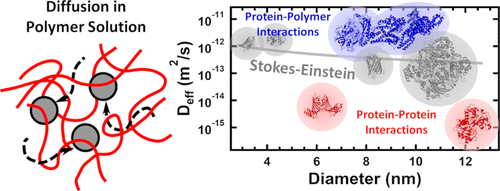当前位置:
X-MOL 学术
›
ACS Appl. Polym. Mater.
›
论文详情
Our official English website, www.x-mol.net, welcomes your feedback! (Note: you will need to create a separate account there.)
Polymer Domains Control Diffusion in Protein–Polymer Conjugate Biosensors
ACS Applied Polymer Materials ( IF 5 ) Pub Date : 2020-09-14 , DOI: 10.1021/acsapm.0c00534 Justin M. Paloni 1 , Bradley D. Olsen 1
ACS Applied Polymer Materials ( IF 5 ) Pub Date : 2020-09-14 , DOI: 10.1021/acsapm.0c00534 Justin M. Paloni 1 , Bradley D. Olsen 1
Affiliation

|
Although surface-based biosensors have been widely used in diagnostic applications, these sensors experience reduced sensitivity in the most common detection fluids because of nonspecific binding effects from nonanalyte molecules. Protein–polymer conjugate thin films have been demonstrated to overcome many of these nonspecific binding issues because of their ability to restrict transport of impurity molecules into the film, but the transport mechanism within these films is not understood. Herein, the diffusion coefficients of 15 different proteins and dextran molecules are measured within protein gels and polymer solutions that mimic the phase-separated protein and polymer domains of the conjugate thin films using fluorescence recovery after photobleaching. Although most molecules have diffusivities that are consistent with size-based diffusion models, several protein diffusivities deviate significantly from these model predictions in polymer solutions. Mixtures of monomeric streptavidin (mSA2), an analyte for the thin-film biosensors, with proteins that diffuse faster than mSA2 in the polymer solutions give greater biosensor sensitivity for mSA2 than solutions of mSA2 alone. Furthermore, a mixture containing several of the proteins in this work is also found to result in greater sensitivity for mSA2 than a pure mSA2 solution. These findings suggest that the polymer domains are primarily responsible for transport in the thin films and, unlike other surface-based biosensors, protein–polymer conjugate biosensors can exhibit enhanced sensitivity in complex sensing mixtures.
中文翻译:

聚合物域控制蛋白质-聚合物共轭生物传感器中的扩散。
尽管基于表面的生物传感器已广泛用于诊断应用,但是由于非分析物分子的非特异性结合作用,这些传感器在最常见的检测液中灵敏度降低。事实证明,蛋白质-聚合物共轭薄膜克服了许多非特异性结合问题,因为它们具有限制杂质分子向薄膜中传输的能力,但人们对这些薄膜内的传输机制尚不了解。本文中,在蛋白质凝胶和聚合物溶液中测量了15种不同蛋白质和右旋糖酐分子的扩散系数,这些蛋白质凝胶和聚合物溶液模拟了光漂白后的荧光回收,从而模拟了共轭薄膜的相分离的蛋白质和聚合物结构域。尽管大多数分子具有与基于大小的扩散模型一致的扩散率,但几种蛋白质的扩散率与聚合物溶液中的这些模型预测值明显不同。单体链霉亲和素(mSA2)(一种薄膜生物传感器的分析物)与在聚合物溶液中扩散速度快于mSA2的蛋白质的混合物,与单独的mSA2溶液相比,对mSA2的生物传感器敏感性更高。此外,与纯mSA2溶液相比,在这项工作中还发现包含几种蛋白质的混合物对mSA2的敏感性更高。这些发现表明,聚合物结构域主要负责薄膜中的运输,与其他基于表面的生物传感器不同,蛋白质-聚合物共轭生物传感器在复杂的传感混合物中可以表现出更高的灵敏度。在聚合物溶液中,几种蛋白质的扩散率明显不同于这些模型预测。单体链霉亲和素(mSA2)(一种薄膜生物传感器的分析物)与在聚合物溶液中扩散速度快于mSA2的蛋白质的混合物,与单独的mSA2溶液相比,对mSA2的生物传感器敏感性更高。此外,与纯mSA2溶液相比,在这项工作中还发现包含几种蛋白质的混合物对mSA2的敏感性更高。这些发现表明,聚合物结构域主要负责薄膜中的转运,与其他基于表面的生物传感器不同,蛋白质-聚合物共轭生物传感器在复杂的传感混合物中可以表现出更高的灵敏度。在聚合物溶液中,几种蛋白质的扩散率明显不同于这些模型预测。单体链霉亲和素(mSA2)(一种薄膜生物传感器的分析物)与在聚合物溶液中扩散速度快于mSA2的蛋白质的混合物,与单独的mSA2溶液相比,对mSA2的生物传感器敏感性更高。此外,与纯mSA2溶液相比,在这项工作中还发现包含几种蛋白质的混合物对mSA2的敏感性更高。这些发现表明,聚合物结构域主要负责薄膜中的转运,与其他基于表面的生物传感器不同,蛋白质-聚合物共轭生物传感器在复杂的传感混合物中可以表现出更高的灵敏度。薄膜生物传感器的一种分析物,其蛋白质在聚合物溶液中的扩散速度比mSA2快,因此比单独的mSA2溶液对mSA2的生物传感器灵敏度更高。此外,与纯mSA2溶液相比,在这项工作中还发现包含几种蛋白质的混合物对mSA2的敏感性更高。这些发现表明,聚合物结构域主要负责薄膜中的运输,与其他基于表面的生物传感器不同,蛋白质-聚合物共轭生物传感器在复杂的传感混合物中可以表现出更高的灵敏度。薄膜生物传感器的一种分析物,其蛋白质在聚合物溶液中的扩散速度比mSA2快,因此比单独的mSA2溶液对mSA2的生物传感器灵敏度更高。此外,与纯mSA2溶液相比,在这项工作中还发现包含几种蛋白质的混合物对mSA2的敏感性更高。这些发现表明,聚合物结构域主要负责薄膜中的运输,与其他基于表面的生物传感器不同,蛋白质-聚合物共轭生物传感器在复杂的传感混合物中可以表现出更高的灵敏度。还发现,在这项工作中包含几种蛋白质的混合物比纯mSA2溶液对mSA2的敏感性更高。这些发现表明,聚合物结构域主要负责薄膜中的运输,与其他基于表面的生物传感器不同,蛋白质-聚合物共轭生物传感器在复杂的传感混合物中可以表现出更高的灵敏度。还发现,在这项工作中包含几种蛋白质的混合物比纯mSA2溶液对mSA2的敏感性更高。这些发现表明,聚合物结构域主要负责薄膜中的运输,与其他基于表面的生物传感器不同,蛋白质-聚合物共轭生物传感器在复杂的传感混合物中可以表现出更高的灵敏度。
更新日期:2020-11-13
中文翻译:

聚合物域控制蛋白质-聚合物共轭生物传感器中的扩散。
尽管基于表面的生物传感器已广泛用于诊断应用,但是由于非分析物分子的非特异性结合作用,这些传感器在最常见的检测液中灵敏度降低。事实证明,蛋白质-聚合物共轭薄膜克服了许多非特异性结合问题,因为它们具有限制杂质分子向薄膜中传输的能力,但人们对这些薄膜内的传输机制尚不了解。本文中,在蛋白质凝胶和聚合物溶液中测量了15种不同蛋白质和右旋糖酐分子的扩散系数,这些蛋白质凝胶和聚合物溶液模拟了光漂白后的荧光回收,从而模拟了共轭薄膜的相分离的蛋白质和聚合物结构域。尽管大多数分子具有与基于大小的扩散模型一致的扩散率,但几种蛋白质的扩散率与聚合物溶液中的这些模型预测值明显不同。单体链霉亲和素(mSA2)(一种薄膜生物传感器的分析物)与在聚合物溶液中扩散速度快于mSA2的蛋白质的混合物,与单独的mSA2溶液相比,对mSA2的生物传感器敏感性更高。此外,与纯mSA2溶液相比,在这项工作中还发现包含几种蛋白质的混合物对mSA2的敏感性更高。这些发现表明,聚合物结构域主要负责薄膜中的运输,与其他基于表面的生物传感器不同,蛋白质-聚合物共轭生物传感器在复杂的传感混合物中可以表现出更高的灵敏度。在聚合物溶液中,几种蛋白质的扩散率明显不同于这些模型预测。单体链霉亲和素(mSA2)(一种薄膜生物传感器的分析物)与在聚合物溶液中扩散速度快于mSA2的蛋白质的混合物,与单独的mSA2溶液相比,对mSA2的生物传感器敏感性更高。此外,与纯mSA2溶液相比,在这项工作中还发现包含几种蛋白质的混合物对mSA2的敏感性更高。这些发现表明,聚合物结构域主要负责薄膜中的转运,与其他基于表面的生物传感器不同,蛋白质-聚合物共轭生物传感器在复杂的传感混合物中可以表现出更高的灵敏度。在聚合物溶液中,几种蛋白质的扩散率明显不同于这些模型预测。单体链霉亲和素(mSA2)(一种薄膜生物传感器的分析物)与在聚合物溶液中扩散速度快于mSA2的蛋白质的混合物,与单独的mSA2溶液相比,对mSA2的生物传感器敏感性更高。此外,与纯mSA2溶液相比,在这项工作中还发现包含几种蛋白质的混合物对mSA2的敏感性更高。这些发现表明,聚合物结构域主要负责薄膜中的转运,与其他基于表面的生物传感器不同,蛋白质-聚合物共轭生物传感器在复杂的传感混合物中可以表现出更高的灵敏度。薄膜生物传感器的一种分析物,其蛋白质在聚合物溶液中的扩散速度比mSA2快,因此比单独的mSA2溶液对mSA2的生物传感器灵敏度更高。此外,与纯mSA2溶液相比,在这项工作中还发现包含几种蛋白质的混合物对mSA2的敏感性更高。这些发现表明,聚合物结构域主要负责薄膜中的运输,与其他基于表面的生物传感器不同,蛋白质-聚合物共轭生物传感器在复杂的传感混合物中可以表现出更高的灵敏度。薄膜生物传感器的一种分析物,其蛋白质在聚合物溶液中的扩散速度比mSA2快,因此比单独的mSA2溶液对mSA2的生物传感器灵敏度更高。此外,与纯mSA2溶液相比,在这项工作中还发现包含几种蛋白质的混合物对mSA2的敏感性更高。这些发现表明,聚合物结构域主要负责薄膜中的运输,与其他基于表面的生物传感器不同,蛋白质-聚合物共轭生物传感器在复杂的传感混合物中可以表现出更高的灵敏度。还发现,在这项工作中包含几种蛋白质的混合物比纯mSA2溶液对mSA2的敏感性更高。这些发现表明,聚合物结构域主要负责薄膜中的运输,与其他基于表面的生物传感器不同,蛋白质-聚合物共轭生物传感器在复杂的传感混合物中可以表现出更高的灵敏度。还发现,在这项工作中包含几种蛋白质的混合物比纯mSA2溶液对mSA2的敏感性更高。这些发现表明,聚合物结构域主要负责薄膜中的运输,与其他基于表面的生物传感器不同,蛋白质-聚合物共轭生物传感器在复杂的传感混合物中可以表现出更高的灵敏度。



























 京公网安备 11010802027423号
京公网安备 11010802027423号